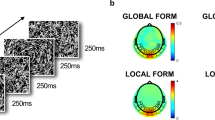Abstract
IT is widely accepted that dyslexics have deficits in reading and phonological awareness1,2, but there is increasing evidence that they also exhibit visual processing abnormalities that may be confined to particular portions of the visual system3,4. In primate visual pathways, inputs from parvocellular or magnocellular layers of the lateral geniculate nucleus remain partly segregated in projections to extrastriate cortical areas specialized for processing colour and form versus motion5–10. In studies of dyslexia, psychophysical3 and anatomical4 evidence indicate an anomaly in the magnocellular visual subsystem. To investigate the patho-physiology of dyslexia, we used functional magnetic resonance imaging (fMRI) to study visual motion processing in normal and dyslexic men. In all dyslexics, presentation of moving stimuli failed to produce the same task-related functional activation in area V5/MT (part of the magnocellular visual subsystem) observed in controls. In contrast, presentation of stationary patterns resulted in equivalent activations in V1/V2 and extrastriate cortex in both groups. Although previous studies have emphasized language deficits, our data reveal differences in the regional functional organization of the cortical visual system in dyslexia.
This is a preview of subscription content, access via your institution
Access options
Subscribe to this journal
Receive 51 print issues and online access
$199.00 per year
only $3.90 per issue
Buy this article
- Purchase on Springer Link
- Instant access to full article PDF
Prices may be subject to local taxes which are calculated during checkout
Similar content being viewed by others
References
Bradley, L. & Bryant, P. Nature 271, 746–747 (1978).
Snowling, M. Psychol. Res. 43, 219–234 (1981).
Lovegrove, W. J., Bowling, A., Badock, D. & Blackwood, M. Science 210, 439–440 (1980).
Livingstone, M., Rosen, G. D., Drislane, F. W. & Galaburda, A. Proc. natn. Acad. Sci. U.S.A. 88, 7943–7947 (1991).
Zeki, S. M. Brain Res. 53, 422–427 (1973).
Ungerleider, L. G. & Mishkin, M. in Analysis of Visual behavior (eds Ingle, D. J., Goodale, M. A. & Mansfield, R. J. W.) 549–586 (MIT Press, Cambridge, MA, 1982).
Livingstone, M. & Hubel, D. Science 240, 740–749 (1988).
Maunsell, J. H. R. & Newsome, W. A. Rev. Neurosci. 10, 363–401 (1987).
Van Essen, D. & Maunsell, J. H. R. Trends Neurosci. 6, 370–375 (1983).
Zeki, S. M. & Shipp, S. Nature 335, 311–317 (1988).
Shapley, R. & Perry, V. Trends Neurosci. 9, 229–235 (1986).
Clarke, S. & Miklossy, J. J. comp Neurol. 298, 188–214 (1990).
Kaplan, E. & Shapley, R. J. Physiol., Lond. 330, 125–143 (1982).
Kulikowski, J. & Tolhurst, D. J. Physiol., Lond. 232, 149–162 (1973).
Zihl, J. Brain 106, 313–340 (1983).
Corbetta, M., Miezin, F. M., Dobmeyer, S., Shulman, G. L. & Petersen, S. E. Science 248, 1556–1559 (1990).
Watson, J. D. G. et al. Cerebr. Cortex 3, 79–94 (1993).
Tootell, R. et al. J. Neurosci. 15, 3215–3230 (1995).
Cheng, K., Fujita, H., Kanno, I., Miura, S. & Tanaka, K. J. Neurophysiol. 74, 413–427 (1995).
Eden, G., Stein, J., Wood, H. & Wood, F. Cortex 31, 451–469 (1995).
Eden, G., Stein, J., Wood, H. & Wood, F. Vision Res. 34, 1345–1358 (1994).
Cornelissen, P., Richardson, A., Mason, A., Fowler, S. & Stein, J. Vision Res. 35, 1483–1494 (1995).
Ogawa, S. et al. Proc. natn. Acad. Sci. U.S.A. 89, 5951–5955 (1992).
Kwong, K. K. et al. Proc. natn. Acad. Sci. U.S.A. 80, 5676–5679 (1992).
Dale, A. et al. Soc. Neurosci. Abstr. 21, 10 (1995).
Newsome, W. T. & Paré, F. B. J. Neurosci. 8, 2201–2211 (1988).
Talairach, J. & Tournoux, P. Co-planar Stereotaxic Atlas of the Human Brain (Thieme, New York, 1988).
Sergent, J., Ohta, S. & MacDonald, B. Brain 115, 15–36 (1995).
Zeffiro, T. A., Eden, G. F., Woods, R. P. & vanMeter, J. W. Adv. exp. med. Biol. (in the press).
Woods, R. P., Cherry, S. R. & Mazziota, J. C. J. Comput. assist. Tomogr. 16, 620–633 (1992).
Author information
Authors and Affiliations
Rights and permissions
About this article
Cite this article
Eden, G., VanMeter, J., Rumsey, J. et al. Abnormal processing of visual motion in dyslexia revealed by functional brain imaging. Nature 382, 66–69 (1996). https://doi.org/10.1038/382066a0
Received:
Accepted:
Issue Date:
DOI: https://doi.org/10.1038/382066a0
This article is cited by
-
Duration perception for visual stimuli is impaired in dyslexia but deficits in visual processing may not be the culprits
Scientific Reports (2023)
-
The effect of online visual games on visual perception, oculomotor, and balance skills of children with developmental dyslexia during the COVID-19 pandemic
International Ophthalmology (2023)
-
Reading performance in children with ADHD: an eye-tracking study
Annals of Dyslexia (2022)
-
Deficits in the Magnocellular Pathway of People with Reading Difficulties
Current Developmental Disorders Reports (2022)
-
Dyslexia and age related effects in the neurometabolites concentration in the visual and temporo-parietal cortex
Scientific Reports (2019)
Comments
By submitting a comment you agree to abide by our Terms and Community Guidelines. If you find something abusive or that does not comply with our terms or guidelines please flag it as inappropriate.



